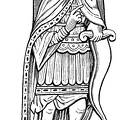7/70
The Germans had brought with them over the Rhine none of the heroic virtues attributed to them by Tacitus when he wrote their history, with the evident intention of making a satire on his countrymen. Amongst the degenerate Romans whom those ferocious Germans had subjugated, civilisation was reconstituted on the ruins of vices common in the early history of a new society by the adoption of a series of loose and dissolute habits, both by the conquerors and the conquered.
- Author
- The Project Gutenberg EBook of Manners, Custom and Dress During the Middle Ages and During the Renaissance Period, by Paul Lacroix
- Posted on
- Tuesday 3 March 2020
- Dimensions
- 792*1573
- Tags
- Middle Ages, Place:Germany, Shield, Soldiers, Spear
- Albums
- Visits
- 2836
- Downloads
- 53
 Download Photo
Download Photo





